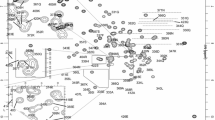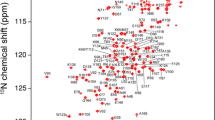Abstract
Bacterial division begins with the formation of a contractile protein ring at midcell, which constricts the bacterial envelope to generate two daughter cells. The central component of the division ring is FtsZ, a tubulin-like protein capable of self-assembling into filaments which further associate into a higher order structure known as the Z ring. Proteins that bind to FtsZ play a crucial role in the formation and regulation of the Z ring. One such protein is ZapA, a widely conserved 21 kDa homodimeric protein that associates with FtsZ filaments and promotes their bundling. Although ZapA was discovered more than a decade ago, the structural details of its interaction with FtsZ remain unknown. In this work, backbone and side chain NMR assignments for the Geobacillus stearothermophilus ZapA homodimer are described. We titrated FtsZ into 15N2H-ZapA and mapped ZapA residues whose resonances are perturbed upon FtsZ binding. This information provides a structural understanding of the interaction between FtsZ and ZapA.




Similar content being viewed by others
References
Dajkovic A, Pichoff S, Lutkenhaus J, Wirtz D (2010) Cross-linking FtsZ polymers into coherent Z rings. Mol Microbiol 78:651–668. doi:10.1111/j.1365-2958.2010.07352.x
Delaglio F, Grzesiek S, Vuister GW, Zhu G, Pfeifer J, Bax A (1995) NMRPipe: a multidimensional spectral processing system based on UNIX pipes. J Biomol NMR 6(3):277–293. doi:10.1007/BF00197809
Erickson HP, Anderson DE, Osawa M (2010) FtsZ in bacterial cytokinesis: cytoskeleton and force generator all in one. Microbiol Mol Biol Rev 74:504–528. doi:10.1128/MMBR.00021-10
Galli E, Gerdes K (2010) Spatial resolution of two bacterial cell division proteins: ZapA recruits ZapB to the inner face of the Z-ring. Mol Microbiol 76:1514–1526. doi:10.1111/j.1365-2958.2010.07183.x
Goddard TD, Kneller DG (1993) Sparky, NMR display and analysis program. University of California, San Francisco
Gueiros-Filho FJ, Losick R (2002) A widely conserved bacterial cell division protein that promotes assembly of the tubulin-like protein FtsZ. Genes Dev 16:2544–2556. doi:10.1101/gad.1014102
Holden SJ, Pengo T, Meibom KL, Fernandez Fernandez C, Collier J, Manley S (2014) High throughput 3D super-resolution microscopy reveals Caulobacter crescentus in vivo Z-ring organization. Proc Natl Acad Sci USA 111:4566–4571. doi:10.1073/pnas.1313368111
Johnson BA, Blevins RA (1994) NMR view—a computer-program for the visualization and analysis of NMR data. J Biomol NMR 4(5):603–614
Low HH, Moncrieffe MC, Lowe J (2004) The crystal structure of ZapA and its modulation of FtsZ polymerisation. J Mol Biol 341:839–852. doi:10.1016/j.jmb.2004.05.031
Mobli M, Maciejewski MW, Gryk MR, Hoch JC (2007) An automated tool for maximum entropy reconstruction of biomolecular NMR spectra. Nat Methods 4:467–468
Roach EJ, Kimber MS, Khursigara CM (2014) Crystal structure and site-directed mutational analysis reveals key residues involved in Escherichia coli ZapA function. J Biol Chem 89(34):23276–23286. doi:10.1074/jbc.M114.561928
Strauss MP, Liew AT, Turnbull L, Whitchurch CB, Monahan LG, Harry EJ (2012) 3D-SIM super resolution microscopy reveals a bead-like arrangement for FtsZ and the division machinery: implications for triggering cytokinesis. PLoS Biol 10:e1001389. doi:10.1371/journal.pbio.1001389
Wishart DS, Sykes BD (1994) The 13C Chemical-Shift Index: a simple method for the identification of protein secondary structure using 13C chemical-shift data. J Biomol NMR 4(2):171–180. doi:10.1007/BF00175245
Wishart DS, Sykes BD, Richards FM (1992) The Chemical Shift Index: a fast and simple method for the assignment of protein secondary structure through NMR spectroscopy. Biochemistry 31(6):1647–1651. doi:10.1021/bi00121a010
Acknowledgments
We thank Fundação de Amparo à Pesquisa do Estado de São Paulo (FAPESP) for supporting this work with Grant 10/51866-0 (Smolbnet 2.0) and for providing M. L. C. Nogueira’s scholarship (2012/15123-8 and 2012/24916-1).
Ethical standards
The experiments of this article comply with Brazil’s current laws.
Author information
Authors and Affiliations
Corresponding author
Rights and permissions
About this article
Cite this article
Nogueira, M.L.C., Sforça, M.L., Chin, Y.K.Y. et al. Backbone and side chain NMR assignments of Geobacillus stearothermophilus ZapA allow identification of residues that mediate the interaction of ZapA with FtsZ. Biomol NMR Assign 9, 387–391 (2015). https://doi.org/10.1007/s12104-015-9615-1
Received:
Accepted:
Published:
Issue Date:
DOI: https://doi.org/10.1007/s12104-015-9615-1




